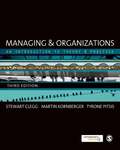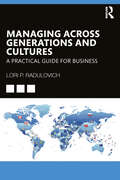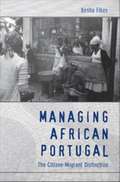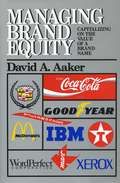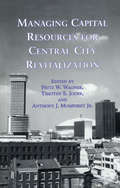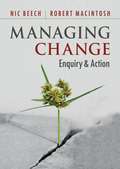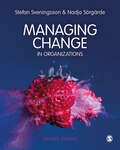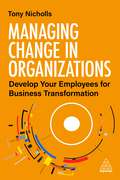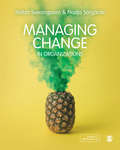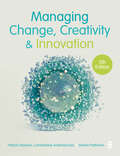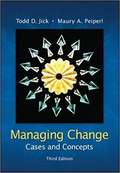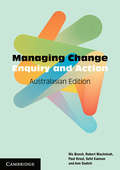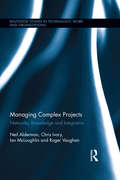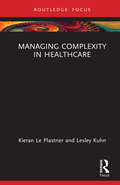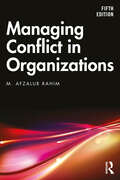- Table View
- List View
Managing & Organizations
by Stewart CleggNow in its Third Edition, this unique and highly esteemed text goes from strength to strength, continuing to offer: - seamless coverage of the essential topics of organizational behaviour - a realist's guide to management capturing the complex life of organizations (the paradoxical, emotional, insecure, self-confident, responsible, irresponsible) and delivers the key themes and debates in an accessible way - interactive, instructive (and fun) learning aids and features, both in the text and on the Companion Website - an attractive, easily navigable, full-colour text design - a guide to further reading including hand-selected journal articles, many of which are available on the Companion Website. As well as cutting-edge content and features, the Third Edition now includes: - clearer, more concise exposition of all you need to know about organizations - expanded coverage of public-sector, informal and non-profit organizations - additional discussion of international cultures - revised case studies to cater for readers across the world at all levels of knowledge and experience - a revisited Companion Website with longer case studies. Over the last seven years, more and more students and tutors have been won over by Managing and Organizations' coverage, wisdom and insight, and this new edition is a yet more essential guide to negotiating and understanding the bustling and complex life of organizations.
Managing A Nation: The Microcomputer Software Catalog--second Edition
by Richard Harwood David Holland John D. Sterman James W. Mercer Margee M. Ensign Martha J. Garrett Gerald O. Barney W. Brian Kreutzer Stephen J. Binhak Jennie M. Hommel J. G. Krishnayya Lynn A. Kurtz Kenneth L. Kvamme Norman Meyers Peter J. Opdahl Ann Elise Schneider Alan M. Thorndike Daniel Tunstall Sheryl WilkinsThis book is a collection of reviews of microcomputer programs of special relevance to those people around the world who are responsible for the management of the current and future affairs and business of their countries.
Managing AIDS: Organizational Responses in Seven European Countries (Routledge Revivals)
by Bernd Marin Patrick KenisFirst published in 1997, this volume examines how, in the last 15 years, HIV/AIDS has become a challenge for public health, public policy and research. Reducing further HIV transmissions as well reducing the personal and social impact of HIV/AIDS requires a wide range of activities developed by a wide range of organizations – the supply of which varies widely between countries, regions and social groups. The book describes the programmes which seem particularly effective in dealing with HIB/AIDS and sets out to explain the disparities in their distribution. It documents and tries to understand both similarities as well as the variety of national approaches taken to cope with HIV/AIDS in a number of European countries. On the basis of the welfare-mix model, six country studies and an introductory chapter draw particular attention to the different mixes of public policies and private non-profit, community-based activities; the functional mixes between different types of services in the areas of prevention, care, research, control and monitoring, interest representation, fund-raising. The mixes between specialized, so-called "exclusive" HIV/AIDS service organizations and services made available by general, comprehensive, or so-called "inclusive" institutions which provide AIDS-specific programmes among other activities will also be elaborated. The whole range of HIV/AIDS activities, from professional services to self-help, is analysed in a comparative perspective. The book is based on data from the European Centre / WHO Collaborative Study Managing AIDS. It is a comparative policy study focused on the role of non-profit organizations in public health and welfare policy, covering several thousands of organizations and HIV/AIDS programmes in six European countries. Unexpected similarities and divergence in AIDS service organizations across Europe were found. The sheer multitude of programmes offered called a surprise to experts in the field, as did remaining conspicuous blank spots or deficiencies in services. Degrees of AIDS policy coherence, prevention efforts, service density and quality, self-help and professionalization, medicalization vs. social integration of HIV/AIDS programmes, sectoral specialization and institutionalization all vary tremendously, as do the efficiency and effectiveness of organizational responses to HIV/AIDS. Interestingly, variations in the supply of activities can hardly be explained by epidemiological patterns and corresponding demand and needs. AIDS management requires long-term institutional strategies and information which cannot be provided by epidemiological or behavioural analysis alone. An effective struggle against HIV/AIDS also requires institution-building, inter-organizational development and policy-field analysis.
Managing Across Generations and Cultures: A Practical Guide for Business
by Lori RadulovichDevelop powerful leadership skills with this concise guide to managing multigenerational and culturally diverse teams. Assess your leadership competencies using eight proven questionnaires that target critical areas for improvement. Build leadership credibility, communicate persuasively, and foster collaboration to drive higher team performance using the practical recommendations provided for each leadership trait.Today, managers face the daunting challenge of leading multigenerational teams from globally diverse cultures. This handbook provides specific steps to develop leadership competencies that create self-driven, high-performing teams by breaking down generational and cultural barriers. Measure your leadership competence with eight self-assessments and learn to: Build Leadership Credibility: Discover your leadership style and the key qualities of great leaders. Learn how to make better decisions, improve outcomes, and navigate conflict when facing adversity Communicate Persuasively and Impactfully: Identify your communication style and the message you reveal through words and body language. Learn to communicate clearly in complex cultural contexts and influence outcomes with data visualization and persuasion techniques Create High-Performing Teams: Bridge generational and cultural differences by sharing knowledge and skills to reverse biases, build trust, increase cultural sensitivity, and learn about global markets Lead Global Teams: Discover how managers leverage resources and nurture innovation for global expansion. Learn which industries exhibit accelerated internationalization and why After completing the self-assessments, you’ll create an Individual Development Plan by selecting specific recommendations to shore up skills and track your progress using the included Leadership Guiding Values Scorecard. Leaders and managers at all levels of seniority and across industries, as well as MBA students, will be inspired to build their leadership career path with insight and confidence using the concise review of global leadership topics and thoughtful recommendations presented in this handbook.
Managing African Portugal: The Citizen-Migrant Distinction
by Kesha FikesIn Managing African Portugal, Kesha Fikes shows how the final integration of Portugal's economic institutions into the European Union (EU) in the late 1990s changed everyday encounters between African migrants and Portuguese citizens. This economic transition is examined through transformations in ideologies of difference enacted in workspaces in Lisbon between the mid-1990s and the early 2000s. Fikes evaluates shifts in racial discourse and considers how both antiracism and racism instantiate proof of Portugal's European "conversion" and modernization. The ethnographic focus is a former undocumented fish market that at one time employed both Portuguese and Cape Verdean women. Both groups eventually sought work in low-wage professions as maids, nannies, and restaurant-kitchen help. The visibility of poor Portuguese women as domestics was thought to undermine the appearance of Portuguese modernity; by contrast, the association of poor African women with domestic work confirmed it. Fikes argues that we can better understand how Portugal interpreted its economic absorption into the EU by attending to the different directions in which working-poor Portuguese and Cape Verdean women were routed in the mid-1990s and by observing the character of the new work relationships that developed among them. In Managing African Portugal, Fikes pushes for a study of migrant phenomena that considers not only how the enactment of citizenship by the citizen manages the migrant, but also how citizens are simultaneously governed through their uptake and assumption of new EU citizen roles.
Managing Brand Equity: Capitalizing on the Value of a Brand Name
by David A. AakerThe most important assets of any business are intangible: its company name, brands, symbols, and slogans, and their underlying associations, perceived quality, name awareness, customer base, and proprietary resources such as patents, trademarks, and channel relationships. These assets, which comprise brand equity, are a primary source of competitive advantage and future earnings, contends David Aaker, a national authority on branding. Yet, research shows that managers cannot identify with confidence their brand associations, levels of consumer awareness, or degree of customer loyalty. Moreover in the last decade, managers desperate for short-term financial results have often unwittingly damaged their brands through price promotions and unwise brand extensions, causing irreversible deterioration of the value of the brand name. Although several companies, such as Canada Dry and Colgate-Palmolive, have recently created an equity management position to be guardian of the value of brand names, far too few managers, Aaker concludes, really understand the concept of brand equity and how it must be implemented. In a fascinating and insightful examination of the phenomenon of brand equity, Aaker provides a clear and well-defined structure of the relationship between a brand and its symbol and slogan, as well as each of the five underlying assets, which will clarify for managers exactly how brand equity does contribute value. The author opens each chapter with a historical analysis of either the success or failure of a particular company's attempt at building brand equity: the fascinating Ivory soap story; the transformation of Datsun to Nissan; the decline of Schlitz beer; the making of the Ford Taurus; and others. Finally, citing examples from many other companies, Aaker shows how to avoid the temptation to place short-term performance before the health of the brand and, instead, to manage brands strategically by creating, developing, and exploiting each of the five assets in turn
Managing Business Performance
by Umit S. BititciMotivate, engage, and achieve lasting success with more effective performance management Managing Business Performance offers a unique blueprint for achieving organisational excellence through improved productivity, efficiency, engagement, and morale. With a unique approach that acknowledges the human aspect of performance management, this book combines technical and social know-how to give you a solid framework for designing, configuring, and managing performance improvement initiatives with sustainable results. You′ll find practical models, techniques, and tools that take you beyond management theory into advice that you can use, with clear explanations that steer you toward the customisations that would best suit your organisation. International case studies illustrate these ideas in action, providing an intimate look at how cultural differences impact management strategies, and insight into how they can be managed. Organisational performance tools and techniques are well established, but many organisations will never realise their full benefit. This book helps you get more out of your performance strategy by showing you how the organisation′s complex social nature impacts real-world outcomes, and how it can be used to drive better performance. Blend technical and social management strategies Keep people motivated and engaged See better results with more staying power Get the very best from your organisation Performance management strategies that fail to take people into account are counterproductive. There′s no better way to de-motivate, demoralise, and disengage the people upon whom the organisation depends. Sustainable success requires a blended approach that utilizes the most effective science within the art of people management, and Managing Business Performance gives you a solid foundation for better business performance strategy.
Managing Capital Resources for Central City Revitalization (Contemporary Urban Affairs #7)
by FRITZ W. WAGNER, TIMOTHY E. JODER AND ANTHONY J. MUMPHREYFirst Published in 2000. This book and its companion volume, Human Capital Investment fo r Central City Revitalization, are the products of a two-year endeavor by the National Center for the Revitalization of Central Cities. The National Center is a consortium of academic institutions that analyzes critical problems facing America’s central cities, evaluates strategies to address those problems, and recommends policy alternatives.
Managing Change
by Nic Beech Robert MacintoshThe ability to manage change successfully is an essential part of business. It is a skill that is much valued by employers, and it is therefore one of the most commonly delivered courses. This book helps you to understand three key activities for managing change: diagnosing, explaining and enacting. Both practical and action-oriented, it gives students and managers the tools they need to deal with the messy reality of change. It combines theory and diagnostic tools with practical examples that focus on actions and outcomes. It also includes short vignettes and longer cases, from a range of international contexts, for classroom study or for use on distance learning courses. Managing Change is written for advanced undergraduates and graduate students taking modules on change management, strategy and organizations. Its class-tested approach has been successfully delivered in a wide variety of settings, including over fifty executive short courses with FTSE-listed businesses.
Managing Change in Organizations
by Nadja Sörgärde Stefan SvenningsonManaging Change in Organizations, second edition, explores a broad range of perspectives on change management, encouraging critical reflection and making sense of a complex field of theories. Its unique approach, based around three key perspectives of change, will help you to understand: · How change is accomplished – the tool perspective · What change means for those involved – the process perspective · Why change is initiated (and whether it is necessary) – the critical perspective Updated throughout to include new examples, case studies and exercises, this essential text offers you the chance to learn pragmatic tools for managing change, as well as gain an in-depth understanding of different theories and their values. Stefan Sveningsson is Professor of Business Administration at the School of Economics and Management, Lund University. Nadja Sörgärde is Senior Lecturer in Business Administration at the School of Economics and Management, Lund University.
Managing Change in Organizations
by Nadja Sörgärde Stefan SvenningsonManaging Change in Organizations, second edition, explores a broad range of perspectives on change management, encouraging critical reflection and making sense of a complex field of theories. Its unique approach, based around three key perspectives of change, will help you to understand: · How change is accomplished – the tool perspective · What change means for those involved – the process perspective · Why change is initiated (and whether it is necessary) – the critical perspective Updated throughout to include new examples, case studies and exercises, this essential text offers you the chance to learn pragmatic tools for managing change, as well as gain an in-depth understanding of different theories and their values. Stefan Sveningsson is Professor of Business Administration at the School of Economics and Management, Lund University. Nadja Sörgärde is Senior Lecturer in Business Administration at the School of Economics and Management, Lund University.
Managing Change in Organizations: Develop Your Employees for Business Transformation
by Tony NichollsYou don't have to be a change manager to be managing change. Written for managers, HR and OD professionals, this practical guide tells you everything you need to know to support effective business transformation. Managing Change in Organizations provides practical tips and examples on how to manage the people side of change as well as advice on how to engage staff and support them during times of business flux and uncertainty. There is also expert advice on how to ensure that all change activity in the company is aligned with the overall business goals whether this affects people, practices or processes.There is also expert guidance for HR, OD and management professionals on how to manage staff expectations, communicate change effectively and prioritize wellbeing during times of change. It includes practical tools which explain how to develop everyday activities to support the workforce through noticing, checking-in and navigating. Informed by the author's experience with both public and private sector organizations. this book is crucial reading for all HR and OD professionals as well as line managers needing to manage change in their organizations.
Managing Change in Organizations: How, what and why?
by Dr. Stefan Sveningsson Nadja SörgärdeIn Managing Change in Organizations, Stefan Sveningsson and Nadja Sörgärde explore a broad range of perspectives on change management, encouraging critical reflection and making sense of a complex field of theories. Their unique approach based around three key perspectives of change will help students understand: How change is accomplished – the tool perspective What change means for those involved – the process perspective And Why is change initiated (and is it necessary) – the critical perspective This focus on the common how, what and why questions offers students the chance to learn pragmatic tools for managing change, as well as gain an in-depth understanding of different theories and their value. The book is complemented by a range of online resources including PowerPoint Slides, Multiple Choice Questions, and a selection of SAGE Business Cases and journal articles. Stefan Sveningsson is Professor of Business Administration at the School of Economics and Management, Lund University, Sweden. Nadja Sörgärde is a Senior Lecturer at the School of Economics and Management, Lund University, Sweden.
Managing Change in Organizations: How, what and why?
by Dr. Stefan Sveningsson Nadja SörgärdeIn Managing Change in Organizations, Stefan Sveningsson and Nadja Sörgärde explore a broad range of perspectives on change management, encouraging critical reflection and making sense of a complex field of theories. Their unique approach based around three key perspectives of change will help students understand: How change is accomplished – the tool perspective What change means for those involved – the process perspective And Why is change initiated (and is it necessary) – the critical perspective This focus on the common how, what and why questions offers students the chance to learn pragmatic tools for managing change, as well as gain an in-depth understanding of different theories and their value. The book is complemented by a range of online resources including PowerPoint Slides, Multiple Choice Questions, and a selection of SAGE Business Cases and journal articles. Stefan Sveningsson is Professor of Business Administration at the School of Economics and Management, Lund University, Sweden. Nadja Sörgärde is a Senior Lecturer at the School of Economics and Management, Lund University, Sweden.
Managing Change, Creativity and Innovation
by Patrick Dawson Costas AndriopoulosThis bestselling text brings a fresh and unique approach to managing organizational change, taking the view that change, creativity and innovation are interconnected. It offers a strong theoretical understanding of change, creativity and innovation along with practical guidance and ideas for organizational change and development. The fourth edition comes with: lots of brand-new case studies and examples from around the world extra content on innovation and technology extended discussion and an additional chapter on the people aspects of change that includes culture, sensemaking and temporality Written in an engaging and accessible style, this books is essential for those studying organizational change management or creativity and innovation.
Managing Change, Creativity and Innovation
by Patrick Dawson Costas AndriopoulosThis bestselling text brings a fresh and unique approach to managing organizational change, taking the view that change, creativity and innovation are interconnected. It offers a strong theoretical understanding of change, creativity and innovation along with practical guidance and ideas for organizational change and development. The fourth edition comes with: lots of brand-new case studies and examples from around the world extra content on innovation and technology extended discussion and an additional chapter on the people aspects of change that includes culture, sensemaking and temporality Written in an engaging and accessible style, this books is essential for those studying organizational change management or creativity and innovation.
Managing Change, Creativity and Innovation
by Patrick Dawson Costas Andriopoulos Steven PattinsonNow in its fifth edition, this bestselling text brings a fresh and unique approach to managing organizational change, taking the view that change, creativity and innovation are interconnected. It couples a strong theoretical understanding of change, creativity and innovation with practical guidance and ideas for organizational change and development. With over 40 international case studies, discussing renowned companies like Amazon, Canva, the NFL, and General Motors, as well as new topics such as social innovation in the creative sector, this edition offers real-world insights that resonate across industries. This book is a must-read for Change Management and Organizational Change modules, as well as those focussing on creativity and innovation. Patrick Dawson is Emeritus Professor of Management at the University of Aberdeen. Constantine Andriopoulos is Professor of Innovation and Entrepreneurship and Associate Dean for Entrepreneurship at Cass Business School, City, University of London. Steven Pattinson is Associate Professor of Entrepreneurship at Newcastle Business School, Newcastle University.
Managing Change, Creativity and Innovation
by Patrick Dawson Costas Andriopoulos Steven PattinsonNow in its fifth edition, this bestselling text brings a fresh and unique approach to managing organizational change, taking the view that change, creativity and innovation are interconnected. It couples a strong theoretical understanding of change, creativity and innovation with practical guidance and ideas for organizational change and development. With over 40 international case studies, discussing renowned companies like Amazon, Canva, the NFL, and General Motors, as well as new topics such as social innovation in the creative sector, this edition offers real-world insights that resonate across industries. This book is a must-read for Change Management and Organizational Change modules, as well as those focussing on creativity and innovation. Patrick Dawson is Emeritus Professor of Management at the University of Aberdeen. Constantine Andriopoulos is Professor of Innovation and Entrepreneurship and Associate Dean for Entrepreneurship at Cass Business School, City, University of London. Steven Pattinson is Associate Professor of Entrepreneurship at Newcastle Business School, Newcastle University.
Managing Change: Cases and Concepts (3rd Edition)
by Todd D. Jick Maury PeiperlManaging Change: Cases and Concepts, 3e by Todd Jick and Maury Peiperl is comprised of six modules that introduce common threads in the ensuing case studies and readings on organizational change. The materials in this edition—cases and readings—have been chosen and arranged to introduce change as an integrated process. Cases in the text represent a wide variety of change situations. Accompanying many cases are readings, likewise chosen to reflect a broad range of issues. Some readings provide theoretical underpinnings for a case, supporting the action: others challenge the action with alternative viewpoints. Still others provide broader context—views of the changing world, for example, or commentaries on how we look at change; ideas that go well beyond the issues in any particular case.
Managing Change: Enquiry and Action
by Nic Beech Robert Macintosh Paul Krust Selvi Kannan Ann DadichThe ability to manage change successfully is an essential part of business. It is a skill that is much valued by employers, and it is therefore one of the most commonly delivered courses. This book helps you to understand three key activities for managing change: diagnosing, explaining and enacting. Both practical and action-oriented, it gives students and managers the tools they need to deal with the messy reality of change. It combines theory and diagnostic tools with practical examples that focus on actions and outcomes. It also includes short vignettes and longer cases, from a range of international contexts, for classroom study or for use on distance learning courses. Managing Change is written for advanced undergraduates and graduate students taking modules on change management, strategy and organizations. Its class-tested approach has been successfully delivered in a wide variety of settings, including over fifty executive short courses with FTSE-listed businesses.
Managing Change: From Health Policy to Practice (Organizational Behaviour In Healthcare)
by Ewan Ferlie Louise Fitzgerald Anne Pedersen Susanne WaldorffManaging Change is about implementing health care reforms, policies and programs into everyday practices. The book explores organizational change in health care as influenced by contemporary policy and management concepts, and presents and applies theoretical perspectives.
Managing Chinese Outward Foreign Direct Investment: From Entry Strategy to Sustainable Development in Australia
by Ying Zhu Xueli HuangChina's outward foreign direct investment, for which Australia is one of the largest destinations, has rapidly increased and become an important source of global capital. Nevertheless, Chinese investors have encountered many challenges in making their investment decisions and managing their foreign direct investments for sustainable development and profitability. Managing Chinese Outward Foreign Direct Investment focuses on the management of Chinese outward foreign direct investment, particularly foreign subsidiaries established through merger and acquisition, at the organisational level. Considering investment as a process, the book addresses complex managerial issues from strategic entry decisions to corporate sustainable development. Particular emphases have been placed on the post-acquisition integration and management such as liability of foreignness mitigation, post-acquisition integration, corporate control and governance, human resources and cross-cultural management, and corporate social responsibility.
Managing Complex Projects: Networks, Knowledge and Integration (Routledge Studies in Technology, Work and Organizations)
by Roger Vaughan Neil Alderman Chris Ivory Ian McloughlinConcerned with the management of complex long-term engineering projects, this important volume, of great interest to postgraduate students of business, technology management and engineering, reports on a set of rich, novel and unique findings concerning the conduct and management of three high profile and complex projects. The major investments which constitute complex long-term projects represent an increasingly important source of economic activity, often with particularly significant consequences for economic growth and public policy. This informative volume expertly contributes to broader debates concerning new organizational forms, knowledge management and organizational learning and the management of innovation in project-based settings.
Managing Complexity in Healthcare (Routledge Focus on Business and Management)
by Lesley Kuhn Kieran Le PlastrierManaging Complexity in Healthcare introduces the ComEntEth (Complex Entropic Ethical) model as an integrated bio-medical and philosophical approach to understanding how people get things done in healthcare. Drawing on the complexity sciences, studies of entropy in living organisms, and the ethics of Emmanuel Levinas, healthcare is theorised as energetic relational exchanges between people as entropic and ethical entities that unfold around a central attractor: Reduction in elevated entropy or suffering in patients. Living entities are engaged in a continuous struggle against the tendency to produce entropy. From the cellular to the collective of human endeavours, the tendency of complex systems is to disorder and decay. Yet in the micro-activity of healthcare enterprise, people resist this tendency by expending energy to create order and sustain life. Making sense of how this miraculous work is made possible is the foundation of this book. Through practical examples – from analysis of practitioner burnout, rural and remote healthcare, the functioning of emergency departments, to government, social and institutional responses to the COVID-19 pandemic –this new integral philosophy provides practitioners, managers, policy designers, and scholars an effective way to understand the dynamics of daily processes and practices that link the micro of everyday interactions with the macro-trends of healthcare.
Managing Conflict in Organizations
by M. Afzalur RahimManaging Conflict in Organizations introduces the origins, forms, benefits, and consequences of organizational conflict to students and practitioners and teaches how best to manage conflict to achieve productive outcomes. Conflict has benefits: it may lead to solutions to problems, creativity, and innovation. In contrast, little or no conflict in organizations may lead to stagnation, poor decisions, and ineffectiveness. This book is a vigorous analysis of the rational application of conflict theory in organizations for organizational behavior students, as well as practitioners looking to practice constructive conflict management in their work. This fifth edition has been thoroughly updated to reflect the latest research in the field and explains the effect that research has on practice, with an expanded range of practical examples and cases. It covers emergent topics such as: • Differentials in conflict management styles across generations. • Technology and its effect on conflict style changes. • Cross-cultural studies and diversity. This text is a valuable resource for students, instructors, and researchers in human resource management and organizational behavior, and a practical handbook for practitioners that manage (or manage upward) their colleagues.
